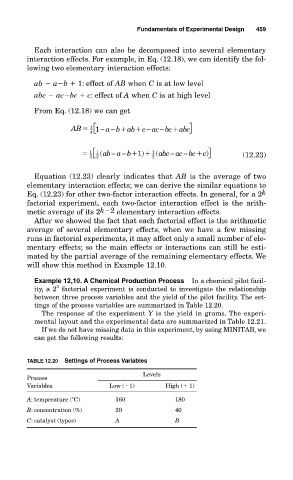Page 500 - Design for Six Sigma a Roadmap for Product Development
P. 500
Fundamentals of Experimental Design 459
Each interaction can also be decomposed into several elementary
interaction effects. For example, in Eq. (12.18), we can identify the fol-
lowing two elementary interaction effects:
ab a b 1: effect of AB when C is at low level
abc ac bc c: effect of A when C is at high level
From Eq. (12.18) we can get
1 ⎡
AB 1−− − − abc ⎦ ⎤
4 ⎣
ab ab c acbc
⎡ (ab a b (abc ac bc ) ⎤ ⎦ (12.23)
−−
−
−
2 2 ⎣
1
1
c
)
1 1
2
Equation (12.23) clearly indicates that AB is the average of two
elementary interaction effects; we can derive the similar equations to
Eq. (12.23) for other two-factor interaction effects. In general, for a 2 k
factorial experiment, each two-factor interaction effect is the arith-
metic average of its 2 k 2 elementary interaction effects.
After we showed the fact that each factorial effect is the arithmetic
average of several elementary effects, when we have a few missing
runs in factorial experiments, it may affect only a small number of ele-
mentary effects; so the main effects or interactions can still be esti-
mated by the partial average of the remaining elementary effects. We
will show this method in Example 12.10.
Example 12,10. A Chemical Production Process In a chemical pilot facil-
3
ity, a 2 factorial experiment is conducted to investigate the relationship
between three process variables and the yield of the pilot facility. The set-
tings of the process variables are summarized in Table 12.20.
The response of the experiment Y is the yield in grams. The experi-
mental layout and the experimental data are summarized in Table 12.21.
If we do not have missing data in this experiment, by using MINITAB, we
can get the following results:
TABLE 12.20 Settings of Process Variables
Levels
Process
Variables Low ( 1) High ( 1)
A: temperature ( C) 160 180
B: concentration (%) 20 40
C: catalyst (types) A B

